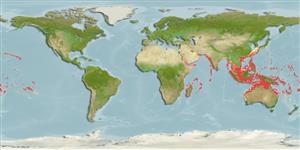Common names from other countries
>
Eupercaria/misc (Various families in series Eupercaria) >
Lutjanidae (Snappers) > Etelinae
Etymology: Aphareus: Greek, aphareys, -eos = water wings under the belly of female tunna (Ref. 45335).
More on author: Lacepède.
Environment: milieu / climate zone / depth range / distribution range
Ecologia
marino associati a barriera corallina; distribuzione batimetrica 0 - 122 m (Ref. 9710). Tropical; 35°N - 31°S, 35°E - 134°W (Ref. 55)
Indo-Pacific: East Africa to the Hawaiian Islands, north to southern Japan, south to Australia. Reported from Cocos Island in the eastern Pacific (Ref. 9821).
Size / Peso / Age
Maturity: Lm ? range ? - ? cm
Max length : 70.0 cm TL maschio/sesso non determinato; (Ref. 5484); common length : 25.0 cm SL maschio/sesso non determinato; (Ref. 9821); peso massimo pubblicato: 906.00 g (Ref. 4887)
Spine dorsali (totale) : 10; Raggi dorsali molli (totale) : 10 - 11; Spine anali: 3; Raggi anali molli: 8.
Adults inhabit inshore coral and rocky reefs and in clear waters of lagoons (Ref. 9821). Pelagic and benthopelagic (Ref. 58302). Occur singly or in small groups. Feed mainly on fishes, but also eat crustaceans. Individuals with brilliant yellow on head may be nuptial males (Ref. 9821). Often curious and approachable (Ref. 9710). Marketed fresh. Minimum depth reported taken from Ref. 128797.
Life cycle and mating behavior
Maturities | Riproduzione | Spawnings | Egg(s) | Fecundities | Larve
Anderson, W.D. Jr. and G.R. Allen, 2001. Lutjanidae. Jobfishes. p. 2840-2918. In K.E. Carpenter and V. Niem (eds.) FAO species identification guide for fishery purposes. The living marine resources of the Western Central Pacific. Vol. 5. Bony fishes part 3 (Menidae to Pomacentridae). FAO, Rome. (Ref. 9821)
IUCN Red List Status (Ref. 130435)
CITES (Ref. 128078)
Not Evaluated
Threat to humans
Reports of ciguatera poisoning (Ref. 30298)
Human uses
Pesca: commerciale; Pesce da pesca sportiva: si
Strumenti
Special reports
Download XML
Fonti Internet
Estimates based on models
Preferred temperature (Ref.
115969): 24.7 - 29.1, mean 28 (based on 1996 cells).
Phylogenetic diversity index (Ref.
82804): PD
50 = 0.7500 [Uniqueness, from 0.5 = low to 2.0 = high].
Bayesian length-weight: a=0.01738 (0.01020 - 0.02960), b=2.95 (2.81 - 3.09), in cm Total Length, based on LWR estimates for this species & (Sub)family-body (Ref.
93245).
Trophic level (Ref.
69278): 4.1 ±0.73 se; based on food items.
Resilienza (Ref.
120179): Medio, tempo minimo di raddoppiamento della popolazione 1.4 - 4.4 anni (tmax = 9).
Fishing Vulnerability (Ref.
59153): Moderate to high vulnerability (48 of 100).
